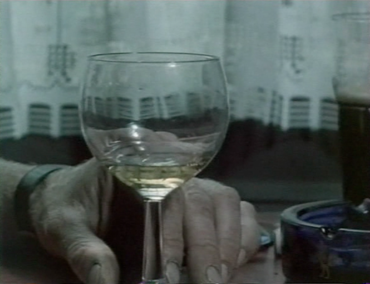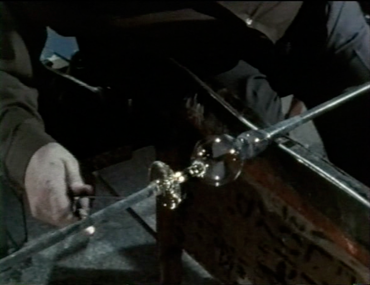JOHN SMITH
Slow Glass
UK, 1991, 16mm, 40 min.
Camera.mov, Steven Wright and Ludd Gang, US, 2012, .mov, 0:13
A Screening as part of THE DEVIL,…
Friday, January 10, 7pm at NWFC
Thomas Beard will introduce the film.
I don’t know if this is true, but someone told me that J.S. Bach put on black gloves to compose his requiem mass. John Smith’s requiem is told by a glazier, a normal, hard working, quietly desperate man who when weighing the past against the future, can give neither preference, and finds nothing distinct to worry about other than the fact that most things don’t stay the way they are very long. To John Smith, it seems most partisan arguments aimed at proving some general truth about the world resolve themselves—in my mind anyway—into what I’d call a nice, existential equilibrium: almost nothing seems to be generally true, almost nothing generally false, so that the best anyone can do is find his own way, reveal it as such, and go on. Counsel, real counsel, in the way Walter Benjamin meant it—useful words about human life—is and always has been very hard to come by. Benjamin believed counsel was the great virtue of told stories, those spoken in the human voice, and that in them we might encounter ourselves in the person of the storyteller.
When this story starts, the glazier, not altogether audible, is in a blubbering, nose-picking state, and his narration has the elegiac and absurd effect of a hangover. Kingsley Amis, whose name is virtually synomous with alcoholism, and who wrote a shelf of books on drinking, described the emotional dimension of a hangover as metaphysical: “When that ineffable compound of depression, sadness (these two are not the same), anxiety, self-hatred, sense of failure and fear for the future begins to steal over you, start telling yourself that what you have is a hangover….You have not suffered a minor brain lesion, you are not all that bad at your job, your family and friends are not leagued in a conspiracy of barely maintained silence about what a shit you are, you have not come at last to see life as it really is. […] Perhaps Franz Kafka’s story The Metamorphosis, which starts with the hero waking up to find he has turned into a man-sized cockroach, is the best literary treatment of all.”
Slow Glass is seeded with a British reality, but the film is not a documentary. It pulls strings, and games with the devices documentaries use to establish reliability. Smith has a sensitivity to the absurdities of documentary grammar, and true to his other films, Slow Glass is a deconstruction of that grammar. Or if not a deconstruction, then a film that argues against itself. Smith seems not so adept at discerning and respecting underlying design, but at trying to invent designs anew. In a manner typical of his work, the attention in Slow Glass comes to rest on the apparatus of lenses, viewfinders, and surfaces through which we watch cinema, but I don’t mean to make it out to be a work that mediates the nature of its own medium and little else. William Gass’s rather postmodern idea of interest being in the pane of glass as much as in what you see through the glass is very powerful to Smith, but Smith is also interested in what you see when you look outside.

John Smith was born in London in 1952 and studied film at the Royal College of Art. After graduating in 1977 he became involved in the activities of the London Filmmakers’ Co-op. Smith’s absence on art curriculums is being amended. In 2010, he received a much overdue retrospective at the Royal College of Art in London. For more information see his website.
Steven Wright (1965) is a comedian. Ludd Gang (1977) is an artist living in Los Angeles. Gang is currently working on the first issue of The Drain, a new film journal.
Thom Andersen said, “machines are what make movies. The institution of film, the cinema, is itself a machine, a process of production whose product is none other than its audience, us.” As such, we have invited Thomas Beard, who runs a cinema, and a good one at that, to give a talk about The Song of Styrene, Slow Glass, and the larger program. Thomas co-directs LIGHT INDUSTRY, a non-profit cinema in Brooklyn with Ed Halter. Together they curated the film PROGRAM for the 2012 Whitney Biennial.

